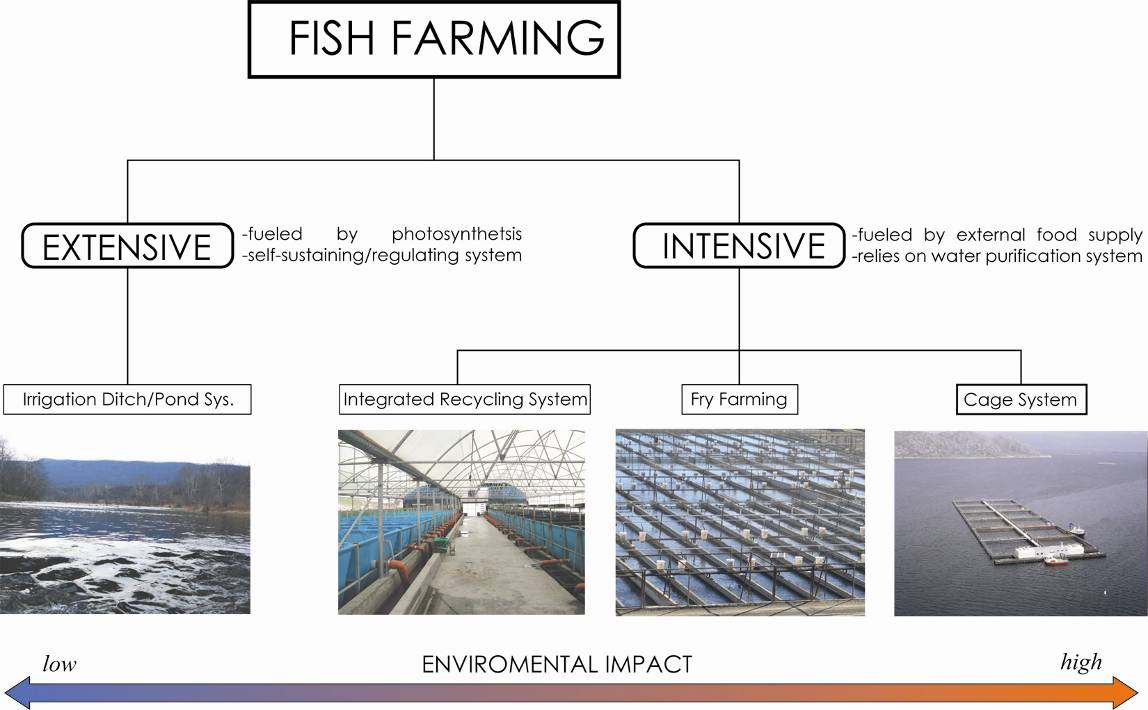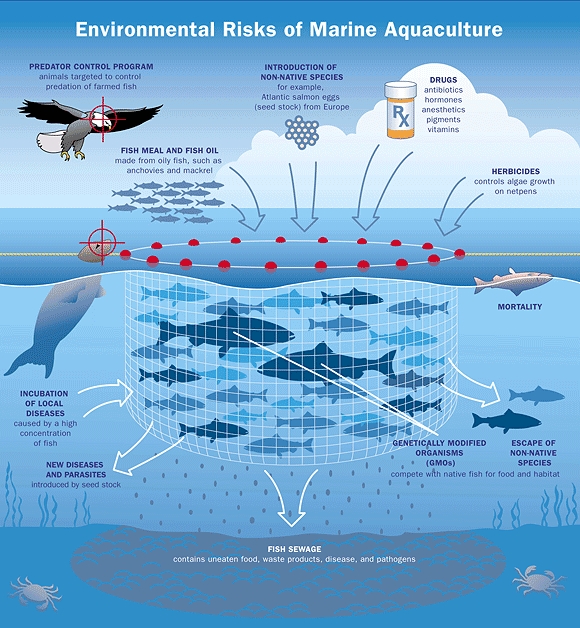“Aquaculture is a rapidly growing, highly valued and extremely important sector of the seafood industry. It is predicted that by 2030 it will account for more than 60% of global seafood production” (Dowle et al.).
 There are two basic forms of aquaculture, extensive systems and intensive systems. Extensive systems are powered by the sun, have a relatively low environmental impact and are self-sustaining and self-regulating. Extensive systems piggy back off of Mother Nature, so they are not suitable in all regions and require more land in general. But they are cleaner and more efficient because they employ nature. One such system, “…has evolved in China over the centuries…In a carp polyculture production system, four species of carp are frown together. One species feeds on phytoplankton. One feeds on zooplankton. A third feeds on aquatic grass. And the fourth is a bottom feeder. These four species thus form a small ecosystem, with each filling a particular niche. This multi species system accounts for the major part of China’s carp harvest of 16 million tons in 2011” (Brown 33-34). So while extensive systems take a more ‘hands off’ approach, they are still capable of producing significant numbers of fish.
There are two basic forms of aquaculture, extensive systems and intensive systems. Extensive systems are powered by the sun, have a relatively low environmental impact and are self-sustaining and self-regulating. Extensive systems piggy back off of Mother Nature, so they are not suitable in all regions and require more land in general. But they are cleaner and more efficient because they employ nature. One such system, “…has evolved in China over the centuries…In a carp polyculture production system, four species of carp are frown together. One species feeds on phytoplankton. One feeds on zooplankton. A third feeds on aquatic grass. And the fourth is a bottom feeder. These four species thus form a small ecosystem, with each filling a particular niche. This multi species system accounts for the major part of China’s carp harvest of 16 million tons in 2011” (Brown 33-34). So while extensive systems take a more ‘hands off’ approach, they are still capable of producing significant numbers of fish.
 Unlike extensive systems, intensive aquaculture relies on external food supplies and cleaning. They also have a much higher environmental impact than extensive systems. It’s not surprising that the concerns toward aquaculture has been directed toward intensive systems. “Environmental impacts from these systems include nutrient enrichment of the surrounding water and sediment due to discharged waste food, fecal matter and excretory products” (Dowle et al.). The result is the seafloor underneath and around the intensive system becomes inundated with waste, which adversely impacts surrounding life. Extensive systems need less interference and are the safer route, but intensive systems will have a role to play if the aquaculture industry is to make a significant contribution to fill the world’s demand for food and more specifically animal protein.
Unlike extensive systems, intensive aquaculture relies on external food supplies and cleaning. They also have a much higher environmental impact than extensive systems. It’s not surprising that the concerns toward aquaculture has been directed toward intensive systems. “Environmental impacts from these systems include nutrient enrichment of the surrounding water and sediment due to discharged waste food, fecal matter and excretory products” (Dowle et al.). The result is the seafloor underneath and around the intensive system becomes inundated with waste, which adversely impacts surrounding life. Extensive systems need less interference and are the safer route, but intensive systems will have a role to play if the aquaculture industry is to make a significant contribution to fill the world’s demand for food and more specifically animal protein.
Brown, Lester R. Full Planet, Empty Plates : the New Geopolitics of Food Scarcity. First ed., New York, W.W. Norton &Amp; Company, 2012.
Dowle, Eddy, et al. “Assessing the Effects of Salmon Farming Seabed Enrichment Using Bacterial Community Diversity and High-Throughput Sequencing.” FEMS Microbiology Ecology, vol. 91, no. 8, 2015, pp. FEMS Microbiology Ecology, 2015, Vol. 91(8).
Figure 1 “Blue Crab Aquaculture.” Blue Crab Farming, 2013, http://bluecrabfarms.com/blue-crab-aquaculture/types-of-crab-farms.
Figure 2 “Aquaculture: The Evironmental Impact.” Mother Jones, WordPress.com, 1 March 2006, http://www.motherjones.com/environment/2006/03/aquaculture-environmental-impact/
